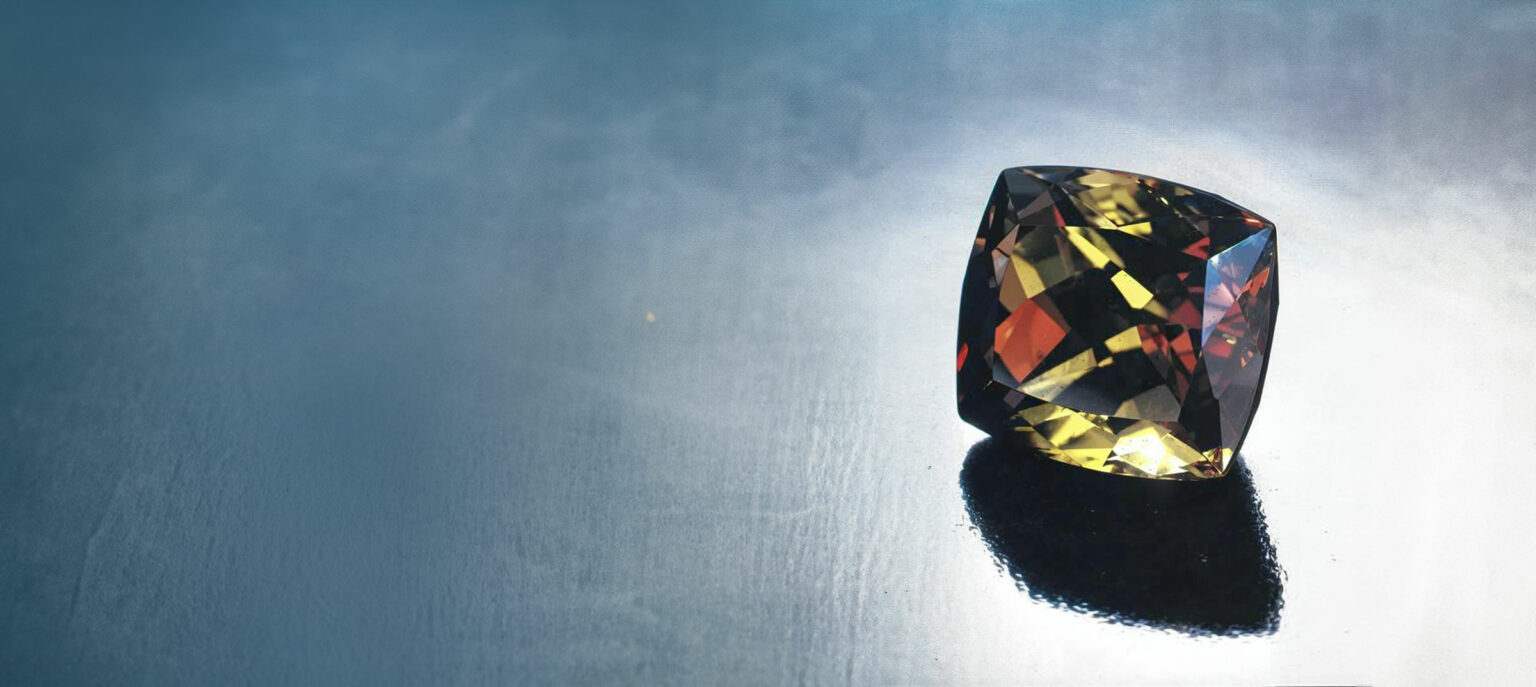Some gems seem to be victims of that oft-repeated childhood proverb: If you can’t say anything nice, don’t say anything at all. Andalusite is one of them.
For sure, this gem has its devotees. But most of them keep their devotion low-key and platonic. Thus andalusite stays a victim of the silent treatment. Even those twin-pillar tomes of gemology, Max Bauer’s Precious Stones and Robert Webster’s Gems, devote minimal attention to this gem.
Granted, stones are often afflicted by annoying amounts of gray and brown. And, yes, it is hard to find fine qualities in sizes over 5 carats. Worse, rutile needles are often visibly present, detracting further from this stone. Last, distinct cleavage can pose a problem for neophyte setters.
Yet there is something good to be said for andalusite. At its best, it offers unique, lovely color—for very little money. “You don’t look to andalusite to find perfection in any one color,” says collector gem specialist Tom Kosik, Casablanca Gems Inc., Arlington, Va. “You look to it to find vivid color contrast.”
That’s because andalusite is a pleochroic stone. This means it gives off different colors when viewed in different directions. With most pleochroic stones, cutters try to minimize this effect, concentrating on obtaining one predominant color. For example, when cutting tanzanite, they will shoot for a Kashmir blue, extinguishing as much as possible the stone’s strong violet component.
Cutters change the rules when it comes to andalusite. Here they shoot to maximize pleochroism. The stone’s two basic hues, yellowish green and orange brown, aren’t very often pleasing enough in themselves to emphasize one over the other. But when cut to be played off each other, stones take on new life through sharp color contrast. The intensify of this contrast is what beauty in andalusite is all about. For this reason, andalusite is an acquired taste. “One must be taught to appreciate it,” says dealer Alex Bahtiarian, Alex Bahtiarian Inc., Englewood, N.J.
The “Phenomenon” Fallacy
Education is the key to connoisseurship of andalusite. But it is hard to educate in print since its best colors are difficult to describe. Try to imagine a cushion or emerald-custone with a pronounced middle area of a light, sometimes steely, yellow green that gives way abruptly to sharply contrasting end areas of bronze or purplish orange-brown.
Some dealers told us to look for pink in the brown, but we observed it only in all-brown round stones and never in fancy shapes where strong pleochroic effects are best emphasized (shown to us. Occasionally, all-pink or all-green stones are cut, but the one or two we saw were rounds with very hazy, cloudy colors. Such stones are only of interest to collectors.
However, we mention these pinkish-brown and grayish-green stones because it is their colors that most reminded us of the colors found in alexandrite, a color-change gem to which andalusite is always compared. Indeed, andalusite is called “the poor man’s alexandrite.” But such a backhanded compliment virtually dooms its appeal, although it is clear that andalusite may once have been sold as the far more costly chrysoberyl. Bauer hints as much in the 1909 edition of Precious Stones.
Alexandrite is a chrysoberyl that displays color change when viewed in different lighting conditions. In daylight, stones exhibit strong greens modified by yellow, brown and gray. At its best, this green can resemble that of a bluish-green tourmaline; at its worst, a light olive brown-green. Under artificial light, alexandrites display red, often modified by purple and brown. At its best, this red is a raspberry color; at its worst, a muddy purplish-brown. Because it changes by color in different lighting environments, alexandrite is classified as a “phenomenon” stone.
Andalusite, on the other hand, is not a “phenomenon,” stone. It does not change color the way alexandrite does. It simply displays different colors at the same time, thanks, as we said, to its strong pleochroism and, of course, proper cutting. What’s more, these colors bear some similarity—but not a strong resemblance—to those of alexandrite. For instance, the purplish orangy-brown of fine andalusite is a far cry from the raspberry red of fine alexandrite.
We found the same to hold true in comparisons of commercial-grade stones. Due to improper orientation by cutters, the pleochroic effect in most commercial stones is weak or almost absent. Consequently, many parcels of fancy cut andalusites exhibit a basic brownish yellow-green throughout with only flashes of orange at the ends. The main green color doesn’t evoke the far more olive-green color of commercial alexandrite.
A Narrow Niche
As of now, andalusite is a rarity. Bahtiarian is sure the few jewelers who buy it from him have done so more to collect it than to sell it. Jeweler neglect leads to manufacturer indifference. As the photograph on the opposite page makes clear, however, andalusite has a striking beauty that lends itself, we think, to jewelry usage.
For starters, the stone has a hardness of 7-7½ on the Mohs scale, indicating it’s durable. What’s more, the highest price we heard quoted for andalusite, this one a stone over 10 carats, was $200 per carat. The same colors in a more commonly available size, say between 4-5 carats, would not have exceeded $75 per carat, according to our dealer price survey. Below 3 carats, where fine andalusite is most abundant, the price would have been below $50 per carat. And, mind you, these were prices given for clean stones! Spot a few rutile needles, and the price drops considerably.
Therefore, low price, coupled with distinctive beauty, makes andalusite a candidate for unusual jewelry pieces. But because it is so seldomly talked about by dealers, many jewelers think the stone is too rare to support anything but odd-ball usage. In reality, andalusite is available in decent quantities in sizes up to 3 carats. One reason may be the fact that most andalusite sold today comes from hyperactive Brazil (it was originally discovered in Andalusia, Spain) where production of smaller sizes is reported steady in recent years. Sri Lanka, the leading secondary source, has been providing some back-up. Between the two countries, there is enough fine andalusite for enterprising jewelers.
“I recently gave a gift of andalusite jewelry to a friend,” relates Tom Banker, Natural Arts Inc., Newport Beach, Calif. “She says her stone received a lot of flattering attention, much more than she ever expected. This kind of reaction leads me to believe andalusite is a real sleeper.”
The 3.01-carat andalusite shown in the header image was courtesy of Overland Gems, Los Angeles.






